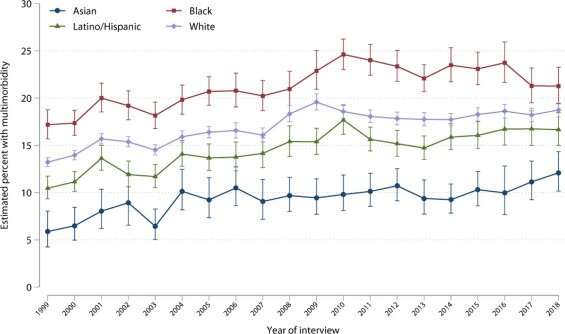Study reveals disparities in prevalence of multiple chronic conditions

Using data from the National Health Interview Survey, a Yale study found persistent racial and ethnic disparities in multimorbidity over a 20-year period.
A Yale study found persistent racial and ethnic disparities in multimorbidity, which is defined as the presence of two or more concurrent chronic health conditions, in the United States over a 20-year period.
Using data from the National Health Interview Survey from 1999 to 2018, investigators from the Yale Center for Outcomes Research and Evaluation (CORE) found that the annual prevalence of important chronic conditions were persistently higher among Black Americans compared with Asian, Latino/Hispanic, and white people.
The study was published Sept. 12 in The American Journal of Medicine.
"These conditions pose a health challenge for people," said Dr. Cesar Caraballo-Cordovez, a postdoctoral associate at Yale School of Medicine and the lead author of the study. "And we found that the presence of many such conditions is persistently more common among Black people. In addition, those with low income also had the highest prevalence of these chronic conditions, overall and within the same race and ethnic group."'
Also, researchers found that these chronic conditions developed earlier in life among Black individuals. "Young and middle-aged Black adults had a burden of chronic conditions equivalent to people from other racial and ethnic groups aged 5–10 years older," said Caraballo-Cordovez.
"Preventing the development of these chronic conditions should be a public health priority, and these findings reveal that social factors such as race and income are associated with chronic disease burdens," said senior author Dr. Harlan M. Krumholz, the Harold H. Hines Jr. Professor of Medicine at Yale and director of CORE. "The findings indicate that unless we address the susceptibility of these populations to the early onset of these chronic condition, we are unlikely to address the health disparities that are so prevalent in our society."
More information: César Caraballo et al, Temporal Trends in Racial and Ethnic Disparities in Multimorbidity Prevalence in the United States, 1999-2018, The American Journal of Medicine (2022). DOI: 10.1016/j.amjmed.2022.04.010





















